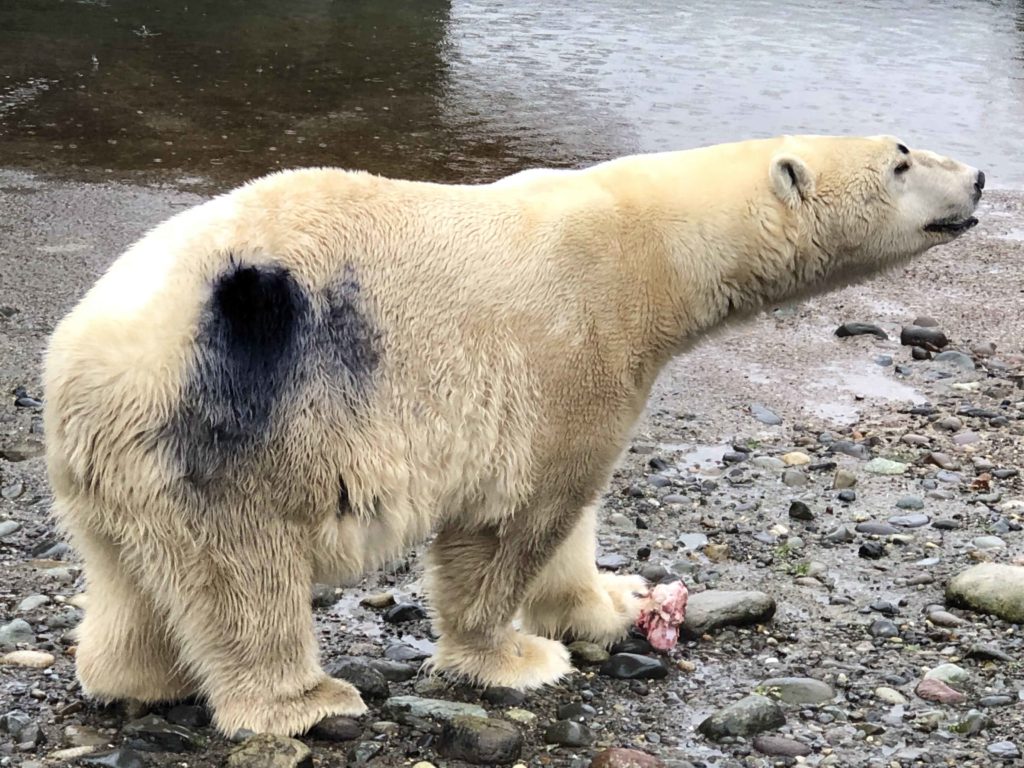UPDATE Oct. 2020: We continue to collaborate with the University of Washington in dyeing polar bear hair and taking samples.
It’s Thursday, and Blizzard is waiting to get his hair dyed.
Standing in the training area behind Arctic Tundra at Point Defiance Zoo & Aquarium, the massive polar bear looks expectantly up at staff biologist Cindy Roberts. One of the bear’s keepers, she’s holding a big bucket that smells appetizingly of raw meat, fish and marshmallows, and Blizzard knows exactly what he has to do to get them – hold still while fellow keeper Sheriden Ploof smears black dye onto his rump.
For Blizzard, it’s a chance to earn treats. For scientists, it’s a way to study polar bear hair to better understand and protect polar bears in the wild, as they face an uncertain, climate-changing future.
Studying Bear Hair
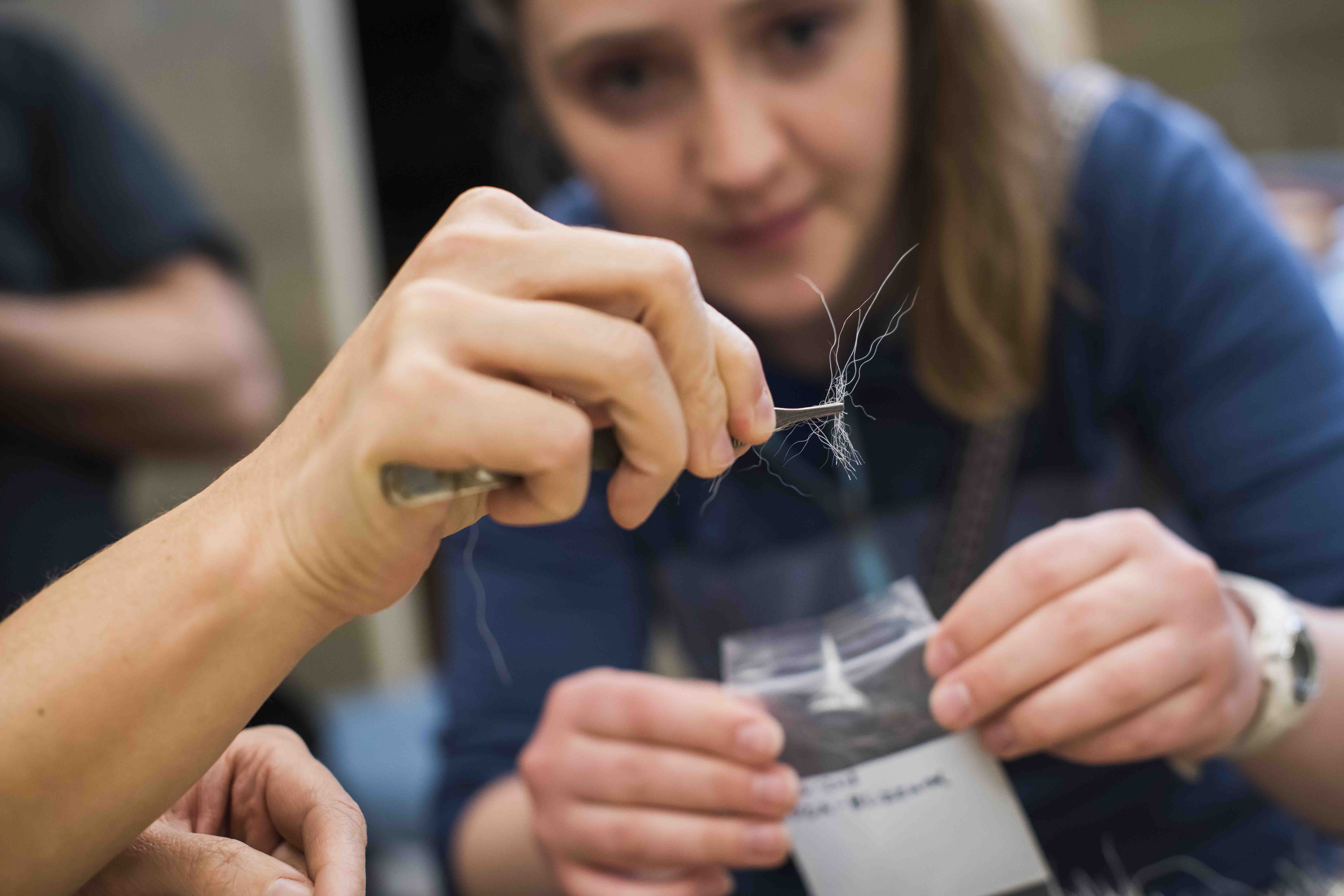
The year-long study is a project led by the University of Washington and the U.S. Geological Survey Alaska Science Center and supported by the Zoo Society’s Dr. Holly Reed Conservation Fund. It investigates polar bear hair growth patterns in order to better understand stress levels, contaminant exposure and nutritional needs of polar bears in the wild – especially as their sea ice melts from global warming.
“By studying how fast polar bear hair grows, we can better understand the ecology and health of polar bears in the wild,” says Jenny Stern, a UW graduate student at the School of Aquatic and Fishery Sciences who’s doing her Ph. D. on polar bear hair growth and co-leading the study. “We do this by dyeing the hair at the root, then taking a hair sample later on to measure the growth.”
At the same time, Blizzard gets fed an isotope that confirms the rate of growth when it’s measured later in hair samples in the lab.
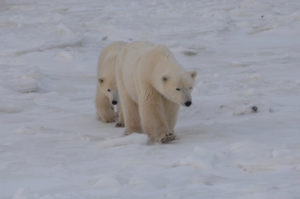
Scientists do track and study wild polar bears, particularly around Churchill, Manitoba as the bears pass by on their annual trek to hunt for seals on new sea ice. But it’s not easy to get a lot of data, and so no-one really knows how fast polar bear hair usually grows, or when.
The solution? Polar bears in zoos, who are much more accessible and (like Blizzard) more amenable to helping humans in exchange for treats.
“We’re thrilled that Blizzard can contribute to our knowledge of polar bear biology,” said Malia Somerville, curator of marine mammals and birds at Point Defiance Zoo & Aquarium. “His involvement will help answer questions about the impact of sea ice loss on polar bear health, and inform conservation decisions for wild polar bears.”
How to Dye Your Polar Bear

But how, exactly, do you dye and get those hair samples?
It takes time, training and a team of dedicated keepers.
“Blizz! Blizzard! That’s a boy!”
On a sunny Thursday morning at the zoo, Stern is measuring out hair dye on a scale in the Arctic Tundra food prep kitchen. As she squeezes and mixes, Roberts and Ploof are outside at Blizzard’s training area, which is securely fenced for everyone’s safety. Roberts is warming Blizzard up with a short training session that he does regularly for his own health care: sitting still, raising one enormous paw, lumbering onto a four-foot-square scale to be weighed. (The result: a healthy 1,054 pounds.)
Each behavior, done on Roberts’ hand and verbal cue, earns Blizzard a couple of chunks of capelin, fat or raw meat, which he gently licks from her fingertips through the barrier. It’s an astonishing sight: a massive apex predator with salivating jaws and teeth as long as your hand responding eagerly and promptly to a human who cares about him – and all polar bears – passionately.
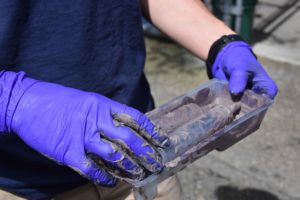
“They’re so smart,” says Roberts, of Blizzard and Boris, the zoo’s other polar bear. Both were rescued animals, and both are now seniors, with a comfortable life that includes pools, a sunroom, living dens and plenty of expert care. “They know exactly what’s going on. They thrive on the mental stimulation of training.”
And so, when it comes to training a more complex behavior like holding still against the barrier, the keeper team has to work extra hard. Since January Ploof has been working on this behavior, mostly used for giving Blizzard vaccines and other voluntary injections. (The bears, like most of the zoo’s animals, voluntarily participate in their own health care, allowing staff to give them the best of that care.)
Patiently, Ploof has worked Blizzard through all the baby steps between touching the barrier with his rump to holding still while she presses a blunt tip to his skin, and finally an injection. Every day, someone in the team has worked on the training, rewarding the bear lavishly afterward.
“I come in to work every day and thank my team so much!” Ploof says. “It takes all of us to do this.”
Sit, Press, Hold
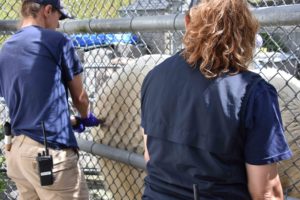
Today, Roberts waits at one end, treats at the ready. Ploof waits by the bear’s rear end. Jenny Stern is hidden in the kitchen – she doesn’t want to distract Blizzard by looking and smelling like a stranger.
With one move, Roberts swings both hands down and across to the right. Blizzard follows with his eyes, then his head.
As he presses his white, furry body against the mesh, Ploof reaches the big syringe through and squeezes the black dye swiftly onto the roots. In an instant he’s pulled away and Roberts feeds treat after treat into those jaws.
One more hold, one more squeeze, and all the dye is in. Feeding the rest of the treats, Roberts and Ploof back away. They’ll come back later to rub in the dye; for now, Blizzard gets the clear message that this is a fun, no-stress exercise. He lumbers off to the outside pool for a swim.
And another time, his keepers will repeat the process to gently extract 10-20 of those long, transparent, straw-like hairs for Stern to take back to the lab. Then the process is repeated.
Bears helping bears
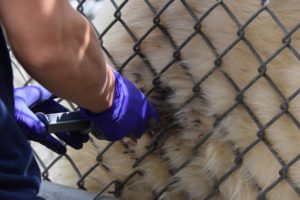
After studying Blizzard’s hair since January, Stern is now ready to expand the study to three other zoos this fall. Collaborators include San Diego Zoo Global, Louisville Zoo, Old Dominion University, Aarhus University, the U.S. Geological Survey and Centre College.
“We think that polar bears molt annually between May and August, but there are no data confirming this timing, or the timing of hair growth,” Stern explains. “Hair growth likely occurs during the sea ice minimum, when bears have limited access to their usual food source. Our goal is to improve our ability to quantify changes in polar bear stress levels, diet and contaminant exposure that come with loss of sea ice. This information is critical to helping us make decisions about their conservation as more and more ice melts.”
For now, all zoo guests will see is a contented polar bear with a black polka dot on his white fur. But behind that dot is the science that may help save his cousins in the wild.
That’s worth any amount of treats.
